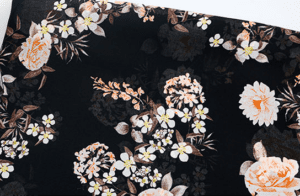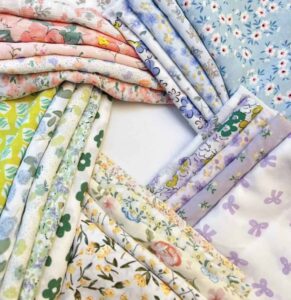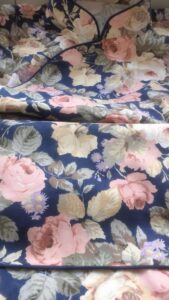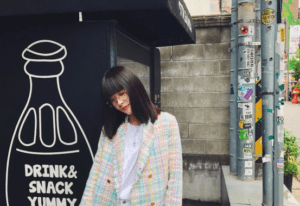Preface
Due to the different chemical structure, supramolecular structure and physical form of the fibres, the printing performance of the fabric is also different from that of conventional fibres. The main problems with the fine printing technology of new differentiated fibre fabrics are.
1) The many fibre components and complex structure of the differential fibre fabrics, the variety of dyestuffs and chemicals in the printing pastes, and the differences in the dyeing performance of the dyestuffs on the fibres.
2) The printing process is long, with high water consumption and waste water discharge.
3) When printing or co-printing, it is difficult to remove the dye from the printed area, which affects the vibrancy of the colour. When washing, the dye stains the printed surface, affecting the vibrancy of the pattern.
4) There are problems with plate making, stock adjustment and printing, which prevent the pattern from achieving a fine finish.
In the production and processing of polyester microfibre/acetate shaped fabrics, the large specific surface area of polyester microfibre increases the light reflectivity, resulting in poorer deep dyeing performance and lighter colours. Acetate fibres have a slightly convex, round or clover-shaped cross-section and are smooth in the longitudinal direction. Due to the differences in the chemical and supramolecular structure of acetate and polyester, the key to dyeing technology is that the disperse dyestuff chosen has the same dyeing properties for polyester and vinyl acetate.
In order to improve the fineness of the print and to avoid to the greatest extent possible the defects of the pair of flowers, on the basis of the traditional anti-pulling dyeing technology for differentiated fibre fabrics, the disperse anti-disperse printing technology is chosen, and the screening of anti-dyeing agents, dyes and other auxiliaries is strengthened, supplemented by the technological operation and control of the plate and paste, in order to achieve the effect of fine printing.
Production process
Selection of disperse dyes
Disperse dyestuff for printing AM-BN, S-BG, 7GL (Texta)
Disperse dyestuff for ground dyeing BD-S, Kajalon Red TL-SF, Kajalon Yellow BRL-S, Kajalon Blue 2RSF (Japan Chemical)
The structure of the dyeable disperse dyestuff is generally a colouring system with 1 to 3 ester groups and an azo structure. The anti-dyeing mechanism is that during high temperature baking (170-190 3C) the anti-dyeing agent in the printing paste reacts with the ground colour disperse dyes and destroys the azo structure of the subsequent ground colour disperse dyes, thus preventing them from being dyed locally on the printed area.
Due to the low apparent colour yield of polyester microfibre and vinyl acetate, the pattern cannot effectively cover the ground colour.
Selection of pastes for disperse dyes
The requirements for the paste are a high colour yield, high definition of the pattern outline and good compatibility with the other components of the printing paste. In addition, polyester is a thermoplastic hydrophobic fibres, not easy to print evenly, the choice of the original paste should have good adhesion, film-forming, elasticity, wettability and ease of washing. The film formed on the fabric should also have a certain degree of softness to prevent peeling. The paste should also have a good water-holding capacity, otherwise it will produce serious bleeding.
The pastes commonly used in disperse dye printing are sodium alginate (or ester), acacia bean gum, guar bean gum and other derivatives of vegetable gums, starch waking semi-emulsified paste and synthetic thickening paste. Sodium alginate paste has good permeability, high colour yield, easy washing, soft feel and is more suitable for circular screen printing machines and fabric moving flat screen printing machines, but has poor acid resistance. Synthetic gum has a high colour giving capacity and good print definition, but is not as easy to wash off as sodium alginate. Dye proof paste A is a high molecular synthetic paste with a higher colour giving capacity than other pastes, which does not cause the colour of some dyes to become darker under high temperature steam conditions. However, this paste is very sensitive to electrolytes and is only suitable for disperse dyestuffs with non-ionic dispersants. In practice, it is possible to mix several pastes to achieve better printing results.
Production process parameters
1) Anti-staining paste
Disperse dye anti-staining paste prescription/g – L’1 Disperse dye 5 – 30
Hydroxymethyl sulphite 20-30
Anti-staining paste A 600-800
2) Disperse dyestuff rolled and dyed in ground colours
Process prescription/g – L’1
Disperse dyes 5 to 20
Levelling agent 2~4
Raw paste 100 ~ 200
3) High temperature roasting
During the baking process at 170 ~ 190 T, the anti-dyeing agent in the colour paste destroys the azo group of the ground colour disperse dyes and prevents the disperse dyes from being dyed locally on the printed parts.
4) Washing process
Due to the low relative molecular mass and good water solubility of the disperse dyestuffs used for acetate dyeing, they can easily re-stain the fibres when washed at high temperatures, making the white ground less white and the colour less vivid. In order to prevent back-staining, the washing temperature should not be too high, and appropriate surfactants should be added to disperse and emulsify the dyestuff, so as to reduce the affinity of the dyestuff for the fibres and obtain a good washing effect. The washing temperature and the choice of auxiliaries are shown in Table 1.
Table 1 Washing temperature and choice of auxiliaries
Depending on the fabric, the washing process can be selected:
(1) Aqueous Wash A/g – L’1 1 ~2
Soaping agent A/g- L’1 1 ~2
Washing temperature/pen 40-50
(II) Caustic soda /g-L 0.5-1
Fuse powder/g – L’1 1 ~2
Washing temperature/°C 55 ~70
Processes
Feeding → flat screen printing machine with multiple sets of printing → 100 ℃ drying, drop cloth → disperse dyeing ground colour → 100 ℃ drying, drop cloth → 170-190 ℃ without high temperature roasting → 8 tanks soap wash (40 – 70 ℃) → flat width open width drop cloth → 100 ℃ loose drying → 175 ~ 190 ℃ shaping expansion → soft finishing (if customer requirements) → finished product
Finished product inspection
Product technical specifications
According to FZ/T 14005-2006 “polyester viscose blended printing and dyeing fabric” first-class product inspection standards, all the indicators meet or exceed similar products at home and abroad, see Table 2.
Table 2 Shrinkage and fastness test results for polyester/acetate blends
The production practice shows that it is feasible to use disperse dyestuff to prevent dyeing and disperse dye printing technology for polyester microfibres (or polyester shaped fibres) blended with acetate fibres. It is also possible to further develop the dye prevention and printing process with a variety of dyestuffs or special components of the dye prevention and printing process, such as the use of fluorescent disperse dyestuff printing, luminous paint printing, foam three-dimensional printing, scintillation sheet printing, etc., to enrich the colour varieties of polyester/acetate blends, polyester filament silk imitation printed fabrics.
























